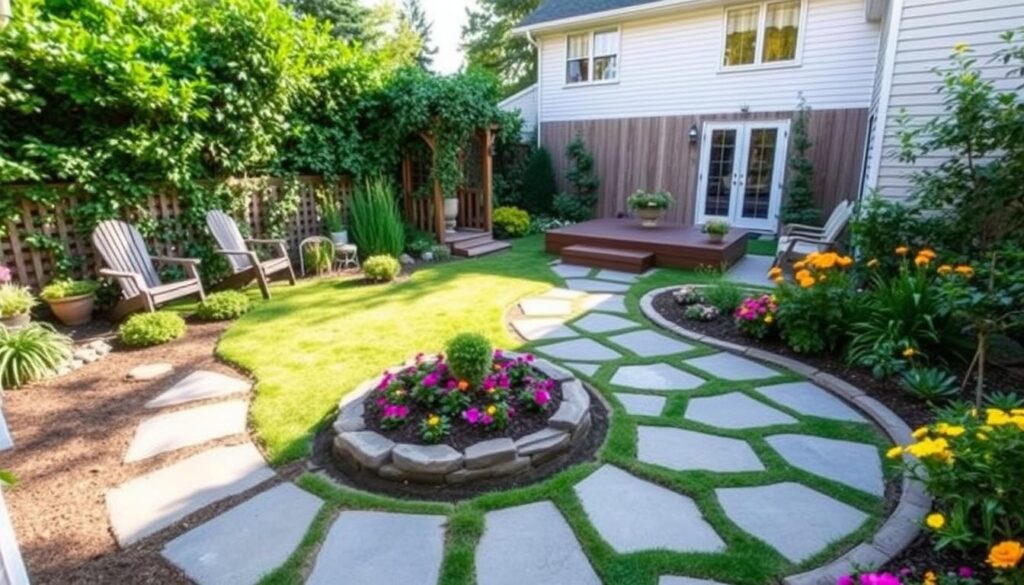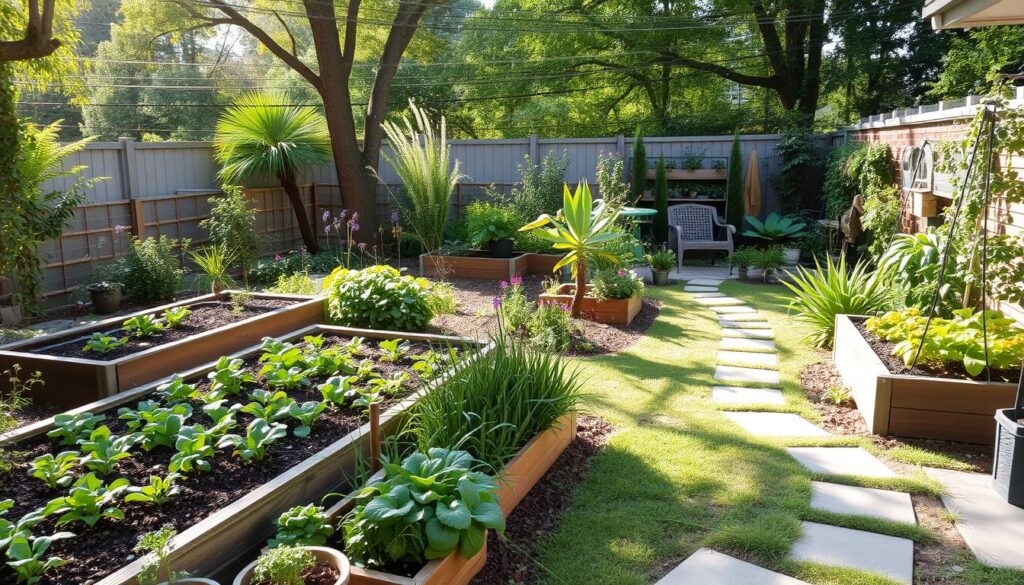Ever thought about turning your outdoor space into a personal retreat? Designing a backyard garden layout can seem tough, but it’s doable. With the right ideas and planning, it can blend seamlessly with your home.
This section will show you different backyard garden layouts. We’ll focus on making your space both functional and beautiful. You’ll learn tips that fit your lifestyle, whether you want a calm spot or a lively area. We’ll also share advice from top gardening experts and landscaping companies.
Key Takeaways
- Evaluate space limitations before diving into design.
- Consider your desired aesthetics for a cohesive look.
- Functionality is key; prioritize your lifestyle preferences.
- Incorporate trusted expert insights for better planning.
- Explore various garden styles to suit your taste.
1. Understanding Your Space for a Garden Design
To create a great garden, you need to know your space well. Things like sunlight, the size of your backyard, and the soil matter a lot. Getting these right helps make your garden both beautiful and useful.
Assessing Sunlight and Shade Areas
Plants do best in different light conditions. Watching how light changes in your garden helps pick the right plants. Plants that love sun need lots of it, while those that like shade don’t need much.
For a DIY garden, make zones based on light. This helps plan your garden better.
Measuring Your Backyard Dimensions
Knowing your backyard’s size is key to good design. Use a tape measure to find out how long and wide it is. Then, draw a diagram to see how you can arrange things.
This planning helps fit in plants, paths, and decorations. It makes your garden space work well.
Considering Soil Type and Drainage
Soil quality is very important for plants. A soil test shows what your soil needs. It also tells you if it drains well.
Choosing plants that match your soil helps your garden. This makes your small backyard look great.
| Factor | Importance | Tips |
|---|---|---|
| Sunlight | Determines suitable plants | Observe light patterns daily |
| Dimensions | Guides layout planning | Measure accurately and scale |
| Soil Type | Affects growth and health | Conduct soil tests regularly |
| Drainage | Prevents water issues | Evaluate slopes and water flow |
2. Choosing the Right Garden Style
Choosing the right garden style can greatly influence your outdoor space. Different themes cater to various tastes and preferences. They highlight aesthetics and practicality.
Understanding the contrast between traditional and modern styles is key. Also, knowing the benefits of container gardening versus in-ground planting helps. This way, you can create a backyard that reflects your personality and aligns with sustainable gardening ideals.
Traditional vs. Modern Themes
Traditional garden themes often feature classic elements. These include symmetrical layouts and formal plantings. They provide a sense of structure and formality.
On the other hand, a modern backyard design emphasizes simplicity. It uses clean lines, minimalistic layouts, and focuses on sustainability. These styles are all about creative space utilization.
- Traditional themes: Symmetrical designs, formal plantings, structured layouts.
- Modern themes: Minimalism, creative space utilization, sustainability.
Container Gardening vs. In-Ground Planting
Container gardening offers mobility and flexibility. It’s perfect for those who want to experiment with different backyard garden layout ideas. You can easily rearrange plants and tailor arrangements based on seasonal changes.
In-ground planting, on the other hand, often leads to greater root growth. This encourages healthier plants in a dedicated area. Each option has its own advantages, depending on your lifestyle and garden goals.
| Aspect | Container Gardening | In-Ground Planting |
|---|---|---|
| Mobility | High – Easy to move plants | Low – Fixed location |
| Design Flexibility | High – Can change arrangements easily | Medium – Less adaptable |
| Maintenance | Regular watering required – Soil dries faster | Less frequent watering – Soil retains moisture better |
| Root Growth | Limited by container size | Unlimited – Natural root expansion |
3. Popular Layouts for Backyard Gardens
Exploring popular layouts for backyard gardens offers many ideas for transforming your outdoor space. This section highlights several efficient designs to inspire your own backyard garden layout ideas. Whether you have a small patch of land or a sprawling yard, these concepts can help you create a vibrant and functional space.
Raised Bed Gardens
Raised bed gardens are both practical and beautiful. They make the most of soil and are easier to weed and water. Elevated planting beds also provide better drainage and warmth for plants, making them a favorite among gardeners.
Incorporating this layout can significantly enhance your ability to enjoy backyard garden inspiration, especially in smaller areas where ground-level garden beds might struggle.
Vertical Gardens
A vertical garden offers an innovative solution for maximizing small outdoor spaces. By using walls, fences, or trellises, you can turn limited areas into stunning displays of greenery. Vertical gardens can support a variety of plants, from herbs to flowers, making them versatile and eye-catching.
This layout is perfect for those looking to add character and depth to a compact garden, fostering an inviting atmosphere.
Formal Garden Designs
For enthusiasts who appreciate structure and symmetry, formal garden designs provide an elegant option. This layout features neatly defined beds, geometric patterns, and well-pruned plants, creating a sophisticated appearance. Such gardens often incorporate pathways and focal points, making them ideal for leisurely strolls.
Drawing inspiration from traditional landscaping principles, formal gardens convey a sense of timeless beauty while offering practical benefits as well.
| Layout Type | Benefits | Best For |
|---|---|---|
| Raised Bed Gardens | Easy maintenance, improved drainage, space-efficient | Small backyards, urban gardening |
| Vertical Gardens | Maximizes space, diverse plants, artistic design | Limited spaces, apartment balconies |
| Formal Garden Designs | Structure, symmetry, traditional aesthetics | Large yards, formal settings |
4. Incorporating Pathways and Walkways
Pathways and walkways are key in any outdoor living space. They help guide visitors and make the area more usable and beautiful. The right materials for your pathways can greatly improve your garden’s space use.
Different Materials for Garden Paths
When making your garden paths, you have many options. Each has its own benefits:
- Gravel: It’s cheap and simple to keep up, giving a rustic vibe.
- Stone: It’s tough and looks great, offering a classic look that fits well with nature.
- Pavers: They come in many colors and shapes, letting you get creative with your design and patterns.
Designing Accessible Walkways
It’s important to make walkways easy to use. Here are some tips:
- Width: Paths should be at least 36 inches wide for easy walking, including for wheelchairs and strollers.
- Surface: Pick materials that won’t slip, keeping everyone safe in any weather.
- Gradient: Paths should be as flat as possible to avoid accidents.

5. Selecting Plants for Your Garden
Choosing the right plants is key to a sustainable garden. Native plants are great for eco-friendly gardens. They need less water and care, helping local ecosystems thrive. Knowing the difference between annuals and perennials is also important for colorful gardens all year.
Native Plants for Eco-Friendly Gardens
Native plants are good for the planet and your garden. They fit well with the local climate and soil. This makes them easy to care for. Some benefits include:
- Less water consumption
- Natural pest resistance
- Support for local wildlife, including pollinators
Annuals vs. Perennials for Year-Round Color
To keep your garden colorful all year, mix annuals and perennials. Here’s a quick look at both:
| Feature | Annuals | Perennials |
|---|---|---|
| Life Cycle | Complete lifecycle in one growing season | Live for multiple years |
| Color Variety | Wide range of colors | More limited color palette |
| Maintenance | Requires replanting each year | Requires less replanting |
6. Adding Focal Points to Your Garden
Creating focal points in your backyard garden makes it more beautiful and interesting. Adding water features and sculptures can really make your outdoor space stand out. These elements not only make your garden look great but also attract wildlife.
Water Features: Ponds and Fountains
Water features bring a calming feel to your garden. They can turn it into a peaceful oasis. Here are some options:
- Ponds: These natural elements attract wildlife like frogs and birds.
- Fountains: The sound of a fountain adds to the serenity, making it a perfect spot to relax.
Sculptures and Garden Art
Adding sculptures or garden art gives your backyard a unique touch. They show off your style and start interesting conversations. Here are some ideas:
- Abstract sculptures: These add a modern touch to your garden.
- Whimsical art pieces: They bring a playful vibe and spark children’s imaginations.
Look for designs that speak to you. Use these tips to find inspiration that reflects your personality and enhances your garden’s look.
| Feature Type | Benefits | Design Ideas |
|---|---|---|
| Ponds | Encourage wildlife, create a natural habitat | Natural stones, aquatic plants |
| Fountains | Add soothing sounds, promote relaxation | Wall-mounted, tiered designs |
| Sculptures | Showcase personal style, enhance visual interest | Abstract, kinetic art |
| Garden Art | Engage viewers, add whimsy | Decorative stakes, upcycled materials |
7. Maximizing Small Spaces
Turning your small backyard into a charming oasis is possible. Use vertical gardening and clever corner use to add lush greenery. This way, you can make the most of your space without feeling cramped.
Vertical Gardening Techniques
Vertical gardening is great for small backyards. It uses wall planters, trellises, and hanging pots to grow plants up, not out. Here are some top vertical gardening ideas:
- Wall-mounted planters: Perfect for herbs and trailing flowers, these planters save floor space.
- Trellises: Ideal for climbing plants like cucumbers and beans, providing both structure and beauty.
- Hanging pots: These can be hung from ceilings or hooks, making the most of vertical space and adding depth to your garden.
Utilizing Corners and Edges Effectively
Using corners and edges smartly is another way to make the most of small outdoor spaces. Planting and structures in these areas can make your garden look better and use space well. Here are some tips:
- Corner beds: Create raised beds or plantings in corners to use often-overlooked areas well.
- Edging with gravel or stone: Use decorative edges to define spaces and create distinct zones in your small backyard.
- Layered plantings: Choose plants of different heights to keep your garden interesting and make it feel bigger.
With these ideas, you can have a beautiful and functional garden in a small backyard. Creativity and careful planning are key. They help make every inch of your outdoor space count.
8. Creating Zones within Your Garden
Designing a garden is more than planting. It’s about creating different zones for various uses. This approach boosts your garden’s function and makes the most of the space. You can set up cozy spots for parties and calm areas for chilling out.
Entertaining Spaces vs. Relaxation Areas
For entertaining, focus on comfort and easy access. Add outdoor seating, fire pits, and dining tables for fun gatherings. For relaxation, think about comfy loungers or hammocks. These spots add variety and beauty to your garden.
Vegetable and Herb Sections
Dedicate areas for veggies and herbs to add variety and make gardening easier. Organized spaces help with upkeep and give you quick access to fresh food. Use raised beds or vertical planters to save space, especially in small areas.

| Zone Type | Features | Benefits |
|---|---|---|
| Entertaining Spaces | Outdoor seating, fire pits, dining areas | Promotes socializing, enhances gatherings |
| Relaxation Areas | Loungers, hammocks, quiet corners | Promotes relaxation, fosters tranquility |
| Vegetable Sections | Raised beds, traditional rows | Easy management, access to fresh produce |
| Herb Sections | Vertical planters, herb spiral | Compact planting, easy access for cooking |
Adding these elements to your garden design brings beauty and function together. Think about how these zones will make your outdoor space better.
9. Maintenance Considerations in Your Layout
Keeping your garden healthy is key. Choose plants that are easy to care for, especially if you’re busy. This makes your garden look great without a lot of work.
Also, set up an irrigation system that meets your plants’ needs. This helps them grow well and saves water.
Easy-to-Care-For Plant Choices
Here are some plants that are low maintenance but add beauty to your garden:
- Lavender – Drought-tolerant and fragrant.
- Sedum – Provides texture with vibrant colors.
- Daylilies – Hardy and come in various hues.
- Hostas – Perfect for shaded areas.
- Coneflower – Attracts pollinators and is easy to maintain.
Irrigation Plans for Efficient Watering
Creating a smart irrigation system can change how you care for your garden. Here are some ideas:
| Method | Benefits | Considerations |
|---|---|---|
| Drip Irrigation | Efficient water use; targets roots | Requires installation and monitoring |
| Soaker Hoses | Easy to set up; low maintenance | May clog over time; need regular checks |
| Rain Barrels | Promotes sustainability; free water source | Requires space; limited to rainy seasons |
10. Personalizing Your Garden Space
Turning your garden into a special place means adding your personal touch. Whether you like cozy or modern, garden furniture makes a big difference. Think about adding benches, dining tables, and loungers.
These items are not just for sitting. They also make your garden a great place for friends and family to hang out. This way, you can really enjoy your outdoor space.
Adding Garden Furniture for Comfort
Choosing the right garden furniture is important. Look for materials that can handle the weather, like teak, eucalyptus, or aluminum. A bench can be a quiet spot, and a dining set is perfect for meals outside.
Don’t be afraid to mix different textures and colors. This makes your garden feel like part of your home.
Incorporating Lighting for Ambiance
Good lighting makes your garden even more special at night. String lights, lanterns, or solar lights can make it magical. They turn your garden into a cozy spot for evening fun.
Lighting can also guide you through your garden and highlight important areas. It adds a warm glow that makes you want to relax and have fun.
FAQ
What are some effective backyard garden layout ideas for small spaces?
For small backyards, think about using vertical gardening. This includes wall-mounted planters or hanging pots. Raised beds are also great as they save space and make upkeep easy.
Don’t forget to use corners and edges for plants. This helps make the most of your space.
How can I create an outdoor living space that feels cozy?
To make your outdoor space cozy, add comfy furniture like benches or lounge chairs. Soft cushions are a must. String lights or lanterns can also add to the cozy feel.
Set up different areas for relaxing, dining, and fun. This makes your space feel welcoming.
What plants are best for sustainable gardening layout?
For sustainable gardening, choose native plants. They fit your local climate, need less water, and attract wildlife. Perennials offer color all year with less upkeep than annuals.
Adding vegetable and herb sections boosts self-sufficiency. It’s good for the planet and your garden.
How can I efficiently use my garden space for both aesthetics and function?
To use space well, add pathways that lead to pretty areas. Vertical gardens add beauty without taking up much space. Divide your garden into zones for fun, rest, and growing things.
This creates a balanced and useful layout.
What are some ways to incorporate pathways into my backyard design?
Use materials like gravel, paving stones, or stepping stones for pathways. They’re pretty and useful. Make walkways easy to follow and connect different garden areas.
This makes your garden more appealing and easy to navigate.
How do I plan for irrigation in my garden layout?
Plan your irrigation by thinking about your plants’ needs. A drip system is efficient for watering. Group plants by water needs to save water and time.
This makes watering easier and helps the environment.
What should I consider when adding focal points to my garden?
When adding focal points, think about water features, sculptures, or unique plants. Make sure they fit your garden’s style and purpose. This adds interest and draws the eye to certain spots.
What are the benefits of creating zones within my garden?
Creating zones makes your garden more functional. It sets areas for relaxing, entertaining, or gardening. This organization makes upkeep easier and offers different experiences outdoors.


